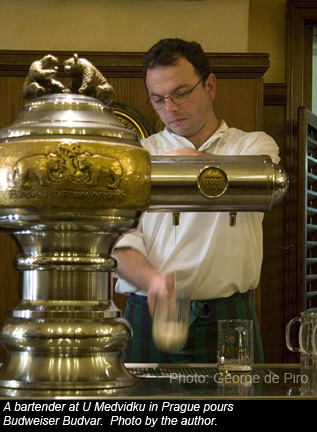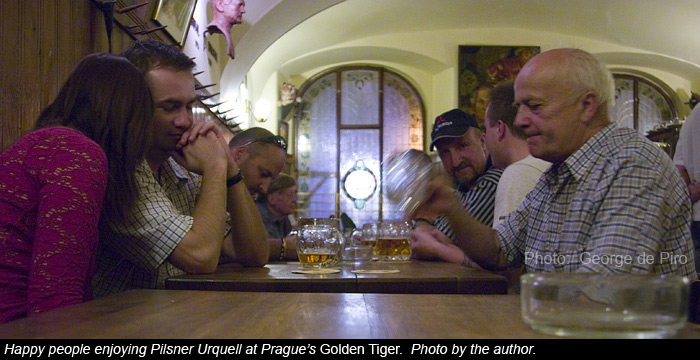|
Of all the world’s beers, those claiming to be “pilsner” are by far the most common. There are actually very few that really deserve to bear this moniker, because they are so different from the original Czech lager. The first pilsner beer was brewed in the town of Plzen, in what is now the western Czech Republic.
This beer, now bearing the label, “Pilsner Urquell,” is the standard to which the other Czech pilsners are brewed. It has a rich, golden color, with aromas of soft malt and spicy, Saaz hops. It has a crisp, malty flavor up front, fading into a smooth finish with plenty of hop bitterness. Despite the large quantity of hops used, their bitterness is not at all harsh, due partly to the quality of the hops, and also to the balancing malt flavor and the famously soft Plzen water.
The chemistry of that renowned water not only yields beers with smooth hop bitterness, but it also allows for the brewing of light-colored beers. There are ion species in water that effect the acidity of the mash (the mixture of hot water and malt). If the mash is too alkaline, the malt starches are not efficiently converted into sugar. Waters high in carbonate ions yield overly alkaline mashes when only pale malts are used.
Dark malts help to acidify the mash, allowing starch conversion to occur, but the resulting beer will be dark in color. In the old days, before water chemistry could be understood and adjusted, brewers had to use dark malts to compensate for alkaline waters. Light-colored beer could not be produced at many European brewing centers.
Another factor contributing to the dark color of beers prior to pilsner was the malt available in years gone by. Malt is made by steeping grain in water until it starts to grow. Just before the young plant emerges from the husk, the grain is transferred to a kiln and dried. Depending on the time and temperature of this step, one can make lighter or darker malts.
Before the mid-19th century, malting technology was such that good-tasting, light-colored malts were not commonly made. The palest beers that could be brewed up to that time were copper-colored. That is how pale ale got its name: it was the lightest-colored beer at the time it was invented!
When the town of Plzen was founded in 1295 by the King of Bohemia, Wenceslas II, the malt situation was the same; only dark beers were produced by the 260 town citizens granted the right to brew in their homes. Through the centuries, the right to brew beer in Plzen was passed down to their descendents. Eventually, a guild was formed to protect the interests of the brewers and ensure that knowledge would be preserved for the next generation of brewers.
Unfortunately for all of Europe, the 30 Years War of 1618-1648 began in Bohemia. This religious conflict ravaged many European cities; the effects on the brewing industry were not positive, and it took many years for Bohemian beer quality to return to pre-war levels. In 1838 some Plzen brewers deemed the quality of a batch to be so poor that they dumped 36 barrels of the stuff in front of the town hall! This lead to the construction of a new brewery in the town by Martin Stelzer.
Stelzer was well-versed in the latest Bavarian brewing technology and hired a German brewer by the name of Josef Groll to oversee brewing operations. Utilizing the new, gently-kilned malts that were now available, Groll brewed the lightest-colored beer the world had seen: a golden, hoppy beverage fermented with yeast obtained from Bavaria. In 1842 the world’s first pilsner was born!
This beer was an instant success. The refreshing hop flavor and soft malt character charmed palates across Europe and later, in North America, too. Marketing this clear, golden liquid was certainly helped by advances in glassware production, which allowed the masses access to clear drinking vessels.
Elsewhere in Europe, the 19th century saw much progress in brewing science. Perhaps most critical was Pasteurs’ 1860 discovery of the importance of yeast to the brewing process. At Carlsberg Laboratories in Denmark, Emil Hansen, building on Pasteurs’ work, pioneered the techniques necessary to isolate pure yeast cultures.
In Bavaria, Spaten’s Gabriel Sedlmayr was busy, applying newly-born refrigeration technology to brewing. This enabled brewers to control their fermentation temperatures with a precision never before known, and to store their beers cold regardless of the time of year. These advances all lead directly to the lager brewing revolution that was soon to sweep the world.
Brewers everywhere were now able to control the quality and consistency of their beers like never before. Light-colored malts, pure yeast strains, and refrigeration for all meant that Pilsner Urquell soon had a lot of competition. As the style emigrated to new parts of the world, it also evolved. Brewers adapted the original recipe to suit local ingredients.
Most of the impersonators were not as hoppy as Pilsner Urquell; Plzen water chemistry permits high hop levels that many other water sources cannot support. Here in America, for reasons of cost and chemistry, some portion of the barley malt in the original Pilsner recipe was replaced by corn. At first, these American pilsners were brewed with relatively high hop levels, and to higher alcohol content than the Czech beer.

Over time, hop rates were drastically reduced and more and more of the malt was replaced by corn, and even rice, to produce beers so light tasting they had no relation to pilsner other than the wording on their labels. To some, it is an insult to the original pilsner that these mass-produced American lagers claim the same moniker. These same people rejoice when foreign courts allow Budweiser Budvar, a true Czech Pilsner born shortly after Pilsner Urquell, to keep its name in the face of challenges from Anheuser-Busch (which must then either change the name of its flagship beer or not market it).
Brewing a Czech-style pilsner at home is easy to do if you have the ability to control your fermentation temperatures with the accuracy required for lager brewing. While Pilsner Urquell uses a complex triple decoction mash to produce its distinctive malt profile, they also use under-modified malt that can yield good results with such treatment. The vast majority of modern malts are well-modified and will produce beer with a thin body and poor head retention if mashed so intensively.
Still, the enterprising homebrewer can use a single decoction to get very similar results (some might even say they are identical). The malt bill is simple: 100% pilsner malt if you are going to decoction mash. If you plan on using an infusion mash, you should add 10-20% Vienna malt to increase the color and make the malt profile more decoction-like, and about 5% Weyermann CaraFoam™ to increase mouthfeel and foam stability.
Extract brewers will have a hard time obtaining the light color and malt flavor necessary for the style, but can achieve it through careful ingredient selection and technique. Buy the freshest, unhopped, light-colored malt extract you can find. Dilute it in enough water so that after one hour of boiling you will have five gallons of wort in the pot. This will minimize color pick-up during the boil.
Whether you use malt or malt extract, you want a starting gravity of 1.048.
The hops are also simple: use imported Czech Saaz for aroma, in pellet form if you can find them. I recommend pellets because they keep far better than whole flowers or plugs, and freshness is key to getting a pleasant hop aroma. Hops that are yellowed and smell in the least bit cheesy should not be used.
If you cannot find Czech-grown Saaz, you could try some newer American varieties; Simcoe and Santiam might yield good results. While they are not Czech Saaz, they are two of the more European-smelling American cultivars. Bittering hops can also be Czech Saaz, but any non-citrusy, mid-alpha variety will yield excellent results.
Use about 10 AAU (HBU) of hops for bittering 5 gallons of beer, and about 2 ounces of Saaz for flavor, and another 2 ounces to dry-hop the young beer.
Brewing water should be soft. If you use city water, you can obtain a free water analysis detailing the ion species present. Be sure to tell the person you speak to that you are a homebrewer; not only will they become instantly friendly and courteous, but they will also know why you need to know about specific ions rather than just lead and pesticides.
You will most likely have to dilute your city water with deionized water of some sort to make water similar to that of Plzen. You can find specifics about Plzen’s water chemistry on the internet. If you use water with high sulfate or carbonate content, the bittering hops will have to be reduced.
You must use a lager yeast. One that produces a malty beer will best emulate Pilsner Urquell, but others can yield fine beers, too. Try different yeasts and settle on a favorite after some extensive taste tests!
Ferment as for any lager, age the beer 6-10 weeks, and enjoy!
|


